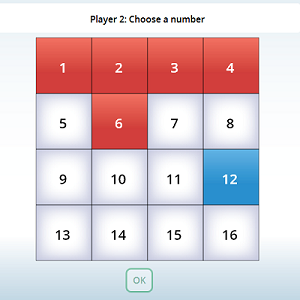 | - Player 1 chooses a number on the game board by clicking on it. The square will be colored blue, as shown for 12. Player 1 receives 12 points for this choice.
- Player 2 then clicks on all the proper factors of Player 1’s number. The proper factors of a number are all the factors of that number, except the number itself. For example, the proper factors of 12 are 1, 2, 3, 4, and 6. Although 12 is also a factor of 12, it is not considered a proper factor. All of the proper factors that Player 2 selects will be colored red. Player 2 will receive 1 + 2 + 3 + 4 + 6 = 16 points for selecting all of the proper factors.
- Players reverse roles. On the next turn, Player 2 colors a new number and gets that many points, and Player 1 colors all the factors of the number that are not already colored and receives the sum of those numbers in points.
- The players take turns choosing numbers and coloring factors.
- If a player chooses a number with no uncolored factors remaining, that player loses a turn and does not get the points for the number selected.
- The game ends when there are no numbers remaining with uncolored factors.
- The player with the greater total when the game ends is the winner.
|
The Factor Game applet was adapted with permission and guidance from "Prime Time: Factors and Multiples," Connected Mathematics Project, G. Lappan, J. Fey, W. Fitzgerald, S. Friel and E. Phillips, Dale Seymour Publications, (1996), pp. 1‑16.